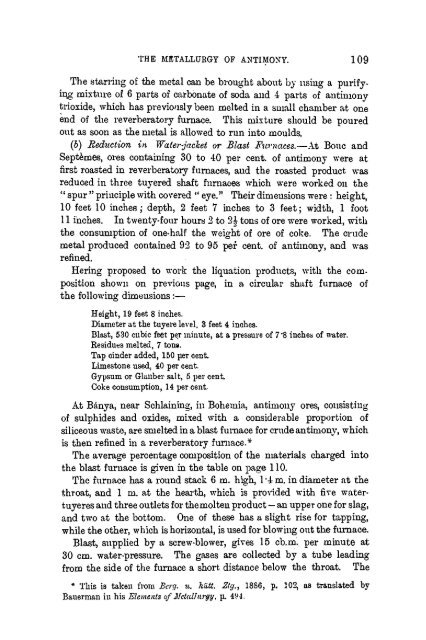antimony - Sciencemadness.org
antimony - Sciencemadness.org
antimony - Sciencemadness.org
Create successful ePaper yourself
Turn your PDF publications into a flip-book with our unique Google optimized e-Paper software.
THE METALLURGY OF ANTIMONY. 109<br />
The starring of the metal can be brought about by using a purifying<br />
mixture of 6 parts of carbonate of soda and 4 parts of <strong>antimony</strong><br />
trioxide, which has previously been melted in a small chamber at one<br />
end of the reverberatory furnace. This mixture should be poured<br />
out as soon as the metal is allowed to run into moulds.<br />
(b) Reduction in Water-jacket or Blast Furnaces.—At Bouc and<br />
Septemes, ores containing 30 to 40 per cent, of <strong>antimony</strong> were at<br />
first roasted in reverberatory furnaces, and the roasted product was<br />
reduced in three tuyered shaft furnaces which were worked on the<br />
" spur " principle with covered " eye." Their dimensions were : height,<br />
10 feet 10 inches; depth, 2 feet 7 inches to 3 feet; width, 1 foot<br />
11 inches. In twenty-four hours 2 to 2 J tons of ore were worked, with<br />
the consumption of one-half the weight of ore of coke. The crude<br />
metal produced contained 92 to 95 per cent, of <strong>antimony</strong>, and was<br />
refined.<br />
Hering proposed to work the liquation products, with the composition<br />
shown on previous page, in a circular shaft furnace of<br />
the following dimensions :—<br />
Height, 19 feet 8 inches.<br />
Diameter at the tuyere level, 3 feet 4 inches.<br />
Blast, 530 cubic feet per minute, at a pressure of 7'8 inches of water.<br />
Residues melted, 7 tona.<br />
Tap cinder added, 150 per cent.<br />
Limestone used. 40 per cent.<br />
Gypsum or Glauber salt, 5 per cent.<br />
Coke consumption, 14 per cent<br />
At Banya, near Schlaining, in Bohemia, <strong>antimony</strong> ores, consisting<br />
of sulphides and oxides, mixed with a considerable proportion of<br />
siliceous waste, are smelted in a blast furnace for crude <strong>antimony</strong>, which<br />
is then refined in a reverberatory furnace.*<br />
The average percentage composition of the materials charged into<br />
the blast furnace is given in the table on page 110.<br />
The furnace has a round stack 6 m. high, 1 *4 m. in diameter at the<br />
throat, and 1 m. at the hearth, which is provided with five watertuyeres<br />
and three outlets for the molten product — an upper one for slag,<br />
and two at the bottom. One of these has a slight rise for tapping,<br />
while the other, which is horizontal, is used for blowing out the furnace.<br />
Blast, supplied by a screw-blower, gives 15 cb.m. per minute at<br />
30 cm. water-pressure. The gases are collected by a tube leading<br />
from the side of the furnace a short distance below the throat. The<br />
* This is taken from Berg. u. htitt. Zlg.t 1886, p. 102, as translated by<br />
Bauerman in his Elements of Metallurgy, p. 494.
















